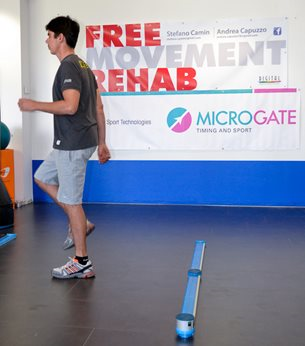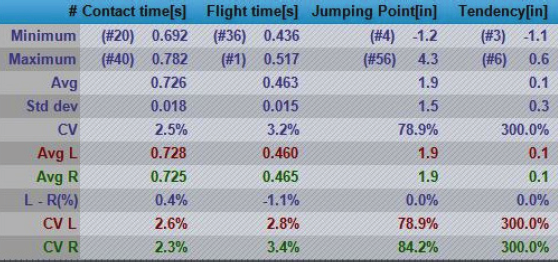Dynamic Balance Control
Balance is one of the key components of performance in the world of sport - you would not be able to walk, run, or jump if you were unable to maintain balance. Static balance control is the foundation of all movement, and can be easily practiced and improved.
When a body is in motion, it requires a different type of skill to stay upright. Dynamic balance control is a person’s ability to maintain balance while in motion. This fundamental element of movement should be monitored and trained with just as much care as all other sport parameters like speed and agility. This is where the March in Place test comes in.
By marching in place, the body is performing a series of one-leg static balance tests, one after the other. When performed at a normal pace, we can begin to understand the body’s ability to balance while in motion. The faster the pace, the harder it will be for the athlete to maintain perfect balance.
Performing this test on an OptoGait system allows us to compare exact flight and contact times of the left and right sides to gain a precise understanding of the body’s coordination. We can then create a baseline for tracking dynamic balance control over time. The better the coordination of the athlete, the closer the timing between the left and right sides will be.
With training, all athletes should be improving their balance control (both static, and dynamic). If this ability is not improving with training, you can be sure that any improvement in their athletic performance is due to a compensatory process that may lead to larger problems down the road.

Seeing is Balancing
Balance is greatly affected by our ability to see, as it relies on the visual ocular reflex (VOR), vestibular, and proprioceptive ability. Therefore, if you wish to gain a true understanding of your ability to balance, you must try doing so with your eyes closed to determine your body’s natural tendency when it is not relying on visual cues.
When the March in Place test is performed with eyes closed, you may notice a number of different effects on your biomechanics including drift, rotation, and an increase in asymmetry. While you may be perfectly balanced when your eyes are open, any of these changes will indicate a lack of proprioceptive ability to compensate for the loss of visual input. With proper dynamic balance control, the body’s tendency should be neutral (no rotation) for both eyes open and eyes closed. You will know you have achieved true balance control when you can perform this test perfectly in any condition of vision
March in Place Analysis & Interpretation
Balance is one of the key components of performance in the world of sport - you would not be able to walk, run, or jump if you were unable to maintain balance. Static balance control is the foundation of all movement, and can be easily practiced and improved.
When a body is in motion, it requires a different type of skill to stay upright. Dynamic balance control is a person’s ability to maintain balance while in motion. This fundamental element of movement should be monitored and trained with just as much care as all other sport parameters like speed and agility. This is where the March in Place test comes in.
By marching in place, the body is performing a series of one-leg static balance tests, one after the other. When performed at a normal pace, we can begin to understand the body’s ability to balance while in motion. The faster the pace, the harder it will be for the athlete to maintain perfect balance.
Performing this test on an OptoGait system allows us to compare exact flight and contact times of the left and right sides to gain a precise understanding of the body’s coordination. We can then create a baseline for tracking dynamic balance control over time. The better the coordination of the athlete, the closer the timing between the left and right sides will be.
With training, all athletes should be improving their balance control (both static, and dynamic). If this ability is not improving with training, you can be sure that any improvement in their athletic performance is due to a compensatory process that may lead to larger problems down the road.

Important Parameters
Contact Time and Flight Time
- L-R% (differential) – the percent difference between the averages of the left and right sides. Numbers around 4.5 and lower are considered within the normal range. The better the balance and coordination of the athlete, the smaller this number will be - with training we hope to see this number decrease over time.
- CV - the most important variable for this test is the coefficient of variability - the absolute measurement of data produced by the body. Step by step as data points are collected, CV will tell you whether they are produced symmetrically or asymmetrically. Ideally, this number will be as close to zero as possible.
Jumping Point and Tendency
- Jumping Point - tracks the lateral movement of the athlete’s midpoint during the test. A negative jumping point value indicates a movement toward the interface towers, while a positive value indicates movement away from the towers. A perfectly balanced person will not have any movement while performing this test
- Tendency - tracks the movement of each individual step
Both of these parameters are usually more significant during a test in which the patient has their eyes closed - a good way to test proprioception when visual acuity is removed.
As balance improves with training, timing between the left and right sides will become more symmetrical and subjects will be able to complete the test without any movement or rotation.
Understanding CV
Let’s say someone steps slow, then fast, slow, then fast. Their differential will be low because the slow/fast pattern can average itself out, but the CV will be high because the absolute difference between slow and fast is large (this step pattern is arrhythmic). The differential only appears low here because the athlete has compensated for this arrhythmacy over time. While their data appears balanced, a high CV indicates that in reality, the “balance” is simply the result of a compensatory process that needs to be addressed in order to reach maximum efficiency.
In sum, it’s the CV that ensures we are not overlooking any underlying asymmetries that may lead to further problems down the road. You can only be sure your dynamic balance control is strong when both differential and CV readings are low.
Improving your Balance Control
Balance is essential for all movement, and improving it is easy. This simple graduated protocol will help strengthen your balance control each day:
- Stand at the ready, looking straight ahead and raise one leg to a 90° angle in front of you. Hold for 15 seconds. If you cannot balance for 15 seconds, keep training. Repeat on opposite leg.
- Repeat the same exercise with eyes closed. Train until you can balance for 15 seconds on both sides
- Increase difficulty by standing on a foam pad. Again, start with eyes open, then move on to eyes closed
- Repeat test while standing on a wobble cuyshion. Eyes open, then eyes closed
- Increase difficulty further by adding weight, moving arms, or balancing with legs extended in front of you. The possibilities are endless!
Back To Applications
Setting up Your optogait


